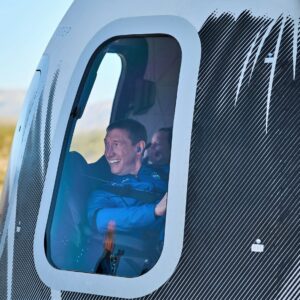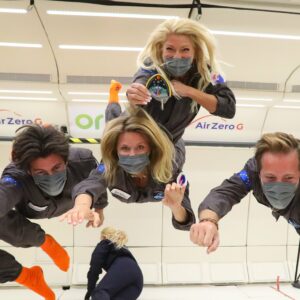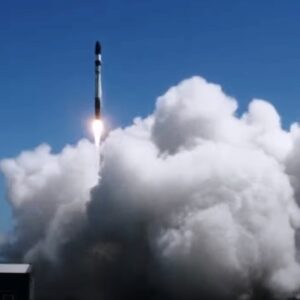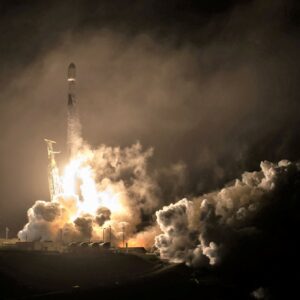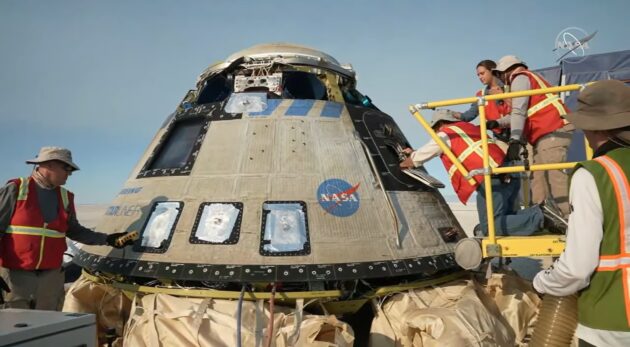
Boeing’s CST-100 Starliner space capsule landed safely amid the sands of New Mexico after a six-day test flight to the International Space Station and back.
This trip was uncrewed — assuming you don’t count a sensor-equipped mannequin nicknamed Rosie the Rocketeer as a crew member. But living, breathing astronauts could fly on Starliner as soon as this year.
All went well today with Starliner’s descent from the space station and its parachute-aided, airbag-cushioned landing at White Sands Missile Range, Cheers arose at NASA’s Mission Control in Houston, where the final stages of the flight test were being tracked.
“Touchdown Starliner,” NASA commentator Brandi Dean said when Starliner hit the gypsum sand at 5:49 p.m. CT (3:49 p.m. PT). “We’re touching down in the desert of New Mexico, marking the completion of Orbital Flight Test 2.”
Boeing commentator Lauren Seabrook said the gumdrop-shaped spacecraft landed about three-tenths of a mile from its target point, which was “basically a bull’s-eye.” After waiting for traces of toxic hydrazine fuel to dissipate, ground crews readied the capsule for post-landing checkouts. Medical team members went through their paces just as if a crew were aboard the spacecraft.
“This is what we were hoping for at the end,” astronaut Butch Wilmore, who’s training for a Starliner mission, said on NASA’s webcast. “A safe landing, culmination of all the hard work. You’ve got to give a huge congratulations to the folks at Boeing. ,,, [They’ve] gone through some difficult situations, and now to culminate in this after a wonderfully successful mission — you couldn’t ask for more.”
It could take a while for Boeing and NASA to do a full analysis of the data from Orbital Flight Test 2, or OFT-2, which followed up on an unsuccessful test in 2019.
Back then, a glitch in Starliner’s automatic timer system left the gumdrop-shaped capsule in the wrong orbit for a space station rendezvous, and the test had to be ended prematurely. Boeing had to cover the cost of fixing Starliner’s flaws and repeating the flight test, with expenses mounting to $595 million so far.
The timer system worked just fine during last week’s launch and ascent to orbit. A couple of Starliner’s maneuvering thrusters shut down prematurely during orbital insertion. Other minor glitches popped up as well, but there was nothing that raised a red flag for completing the mission.
Steve Stich, program manager for NASA’s Commercial Crew Program, said that the balky thrusters were tested again after Starliner pulled away from the space station — and registered only about 25% of the expected thrust. That issue will have to be resolved in the months ahead, but Stich said NASA probably won’t require another uncrewed flight test.
“I don’t see any reason why we can’t proceed toward a crewed flight test next,” he told reporters. “The vehicle performed really well. … We have a few things to work on between now and then, but I don’t really see any showstoppers this time.”
Even though this trip was primarily a practice run, Starliner delivered hundreds of pounds of payload to the space station’s crew, and brought hundreds of pounds of cargo back to Earth.
“It was a great stay by Starliner,” NASA astronaut Bob Hines, who joined the space station’s crew just last month, told Mission Control as the capsule flew away. “We’re a little sad to see her go.”
One of the items delivered to the space station was a U.S. flag, which will be kept aboard the orbital outpost and given to the first astronauts to arrive aboard a Starliner capsule.
NASA selected Boeing and SpaceX to develop crew transport vehicles as replacements for the space shuttle fleet, which was retired in 2011. In the meantime, NASA had to depend on the Russians to fly astronauts on their Soyuz spacecraft, at a cost that eventually rose to more than $90 million per seat.
SpaceX started flying astronauts to the space station and back on its Crew Dragon spacecraft in 2020, but a string of snags delayed the Starliner development effort.
Joel Montalbano, NASA’s space station program manager, said today that he thought Starliner was finally ready to carry astronauts. “We now have a cousin to Dragon and Soyuz that can safely deliver humans to space, and safely return to Earth,” Montalbano said.
Update for 2:10 p.m. PT June 6: An earlier version of this report incorrectly said the balky thrusters that are part of the maneuvering system on Starliner’s service module were built at Aerojet Rocketdyne’s facility in Redmond, Wash. The Redmond team provides the crew module’s thrusters, but the thrusters on the service module are provided by Aerojet Rocketdyne’s Los Angeles team. Sorry about the error!
